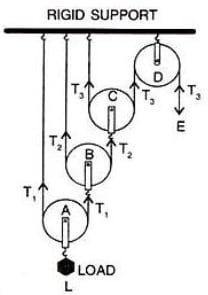Physics
Draw a diagram of combination of three movable pulleys and one fixed pulley to lift up a load. In the diagram, show the directions of load, effort and tension in each strand. Find:
(i) the mechanical advantage,
(ii) velocity ratio and
(iii) the efficiency of the combination in the ideal situation.
Machines
42 Likes
Answer
The diagram is shown below:

In equilibrium,
Effort E = T3 (1)
Tension T1 in the string passing over the pulley A is given as 2T1 = L
T1 = (2)
Tension T2 in the string passing over the pulley B is given as
2T2 = T1
T2=
Substituting value of T1 from equation 2,
T2 = (3)
Tension T3 in the string passing over the pulley C is given as
2T3 = T2
T3 =
Substituting value of T2 from equation 3,
T3 = (4)
In equilibrium, T3 = E
From equation 4,
Load L = 23 x T3 (5)
(ii) As we know, one end of each string passing over a movable pulley is fixed, so the other end of string moves up twice the distance moved by the axle of the movable pulley.
If the load L attached to the pulley A moves a distance d,
then dL = d
Now, the string connected to the axle of pulley B, moves up by a distance,
2 times d = 2d.
Then the string connected to the axle of the pulley C, moves up by a distance,
2 times 2d = 22d
Then the end of the string passing over the fixed pulley D, moves up by a distance,
2 times 22d = 23d.
Hence, dE = 23d.
As we know,
E}{dL} \\[0.5em]
Substituting the values in the formula we get,
Answered By
21 Likes
Related Questions
State four differences between a single fixed pulley and a single movable pulley.
The diagram alongside shows an arrangement of three pulleys A, B and C. The load is marked as L and the effort as E.

(a) Name the pulleys A, B and C.
(b) Mark in the diagram the direction of load (L), effort (E) and tension T1 and T2 in the two strings.
(c) How are the magnitudes of L and E related to the tension T1?
(d) Calculate the mechanical advantage and velocity ratio of the arrangement.
(e) What assumptions have you made in parts (c) and (d)?
Draw a diagram of a block and tackle system of pulleys having a velocity ratio of 5. In your diagram indicate clearly the points of application and the directions of the load L and effort E. Also mark the tension T in each strand.
A woman draws water from a well using a fixed pulley. The mass of the bucket and water together is 6 kg. The force applied by the women is 70 N. Calculate the mechanical advantage. (Take g = 10 m s-2).